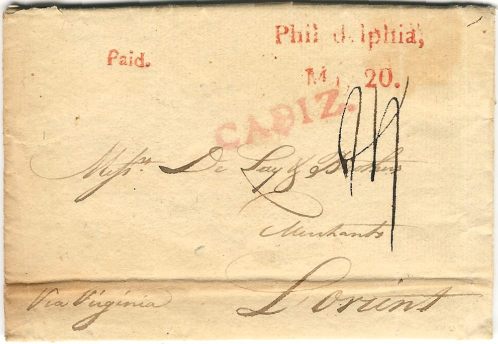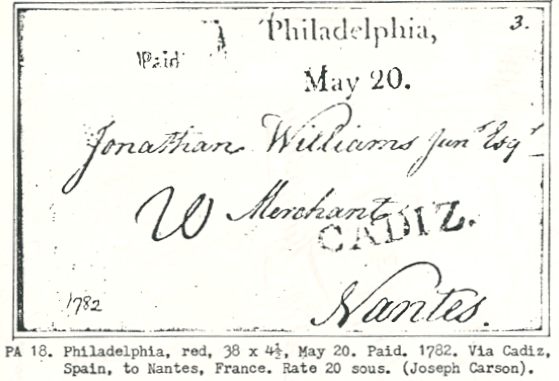|
|
A 1782 Philadelphia Letter

Figure 1.
A March 27, 1782 folded letter from Philadelphia to France.
The letter: The above letter recently appeared at auction in Europe where it was purchased on behalf of a client. At the time of purchase, prior to viewing, I believed that the item was possibly a fake and it was purchased on extension. Upon examination and study, I now believe the item to be genuine in all regards.
The letter is dated Philadelphia, March 27, 1782 and is from John Barclay & Company and is addressed to a merchant at L'Orient, France. The letter is endorsed to be carried "Via Virginia" at lower left. The letter bears a red "Philadelphia May 20" two line postmark and matching "Paid" handstamp. The marking matches the listing in the American Stampless Cover Catalog but is atypical for Philadelphia in two regards. The usual Philadelphia postmarks of this period are all upper case letters and are all abbreviated to one extent or another. Further, all of the markings reported in the catalog are impressed in black ink. Another anomaly is that the letter does not bear any American postal rate. The "1." that appears at top right is a notation that this is a single sheet letter.
The letter was carried by ship to Cadiz, Spain and from there to destination. The manuscript French rate of "24" sols is correct as is the Cadiz transit postmark. The French rate breaks down as 20 sols ship rate for entry at Nantes plus 4 sous inland postage.
Historical background: By March, 1782 the Revolutionary War was near an end. With French assistance the British had been defeated at Yorktown the previous October. However, New York City was still occupied by British forces and the French Navy had left Virginia. There was no secure shipping on the Atlantic as evidenced by the content of this letter which includes:
We are favored with yours of the 7th of October where you inform us that you consigned to our address two bales of merchandise by the Hope Capt. Frazier which we are sorry to inform you was captured by the enemy and carried into N. York. The brig Polly captain Cain was lost on Smyths Island at the Capes of Virginia and it was very late before we received your letter which prevented us from answering sooner. We hope you were fully insured on the shipment and that your only loss will be want of money for a little time. The vessels from France have for some time been very unfortunate but we expect and believe our trade will be better protected and consequently the risk less.
There were infrequent opportunities to get mail out of Philadelphia as the British packet from occupied New York City was obviously not an option for mail to France. The letter writer, John Barclay, had been discharged from the Army as a Captain in January, 1782 and was to become a Mayor of Philadelphia in 1791.
The evidence: The letter and all markings appear to be genuine from examination of the inks and impressions. The impression from the "Paid" handstamp is evident through all layers of paper and was evidently struck from a metal device using considerable force. The ink is an oil base ink and is similar under black light to other inks of the same general period.
The explanation: There is very little mail known from this period and virtually nothing used to foreign destinations for comparison. The usual process for outbound ship mail was to prepay the postage from city of origin to the port the ship was leaving from. In times of peace, the scheduled sailing dates were frequently published in local newspapers so it was not difficult to anticipate a sailing and direct a letter to another port so that the letter could be carried. However, this was not the case early 1782 as the publication of such information was likely to put the ship in jeopardy of capture by the British.
So, for a letter such as this example, written in March, 1782, it was not known when a ship might be available for taking the letter to Europe. The procedure would have been that the letter was held at the Philadelphia Post Office until a potential sailing was identified, then it would have been paid to the appropriate port (in this case it was likely Norfolk, Virginia), then postmarked and bagged with other mail to the port of departure. There was no need to mark the postal rate on the letter as it was paid to the port and no further accounting was required.
A Confirming Example: The cover below is owned by another client. It was illustrated in The Posted Letter In Colonial And Revolutionary America 1628-1790 by Alex L. ter Braake as figure PA18.

Figure 2.
A May 4, 1782 folded letter from Philadelphia to France.
This cover bears the identical postal markings as the letter in Figure 1. It does not bear an American postal rate and the numeral "3." at top right refers to the fact that the letter was three sheets. The owner of this item checked the date for me of the letter and found that it was May 4, 1782. The 20 sols French rate was the rate for delivery at port. This indicates that the letter was carried from Cadiz to Nantes by ship.
Conclusion: These two examples were both treated in the same fashion. They were both held by the Philadelphia Post Office until May 20, 1782 at which time they were sent on to the port of departure. They were carried on the same vessel to Cadiz, Spain and entered the mails, to different addresses at the same time. The fact that two letters from different correspondences exist, carried on the same trip is almost miraculous. The conclusion has to be that a substantial amount of mail must have been carried on this trip and that, although atypical, the Philadelphia markings are genuine.
Richard Frajola (April, 2002)


